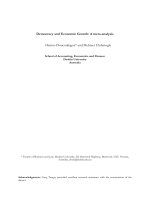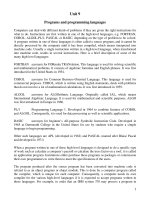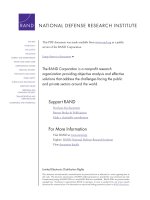Military Jet Engine Acquisition - Technology Basics and Cost-Estimating Methodology pdf
Bạn đang xem bản rút gọn của tài liệu. Xem và tải ngay bản đầy đủ của tài liệu tại đây (3.21 MB, 167 trang )
Obaid Younossi, Mark V. Arena, Richard M. Moore
Mark Lorell, Joanna Mason, John C. Graser
Prepared for the
United States Air Force
Approved for Public Release; Distribution Unlimited
R
Project AIR FORCE
Military Jet Engine
Acquisition
Technology Basics and
Cost-Estimating Methodology
The research reported here was sponsored by the United States Air
Force under Contract F49642-01-C-0003. Further information may
be obtained from the Strategic Planning Division, Directorate of
Plans, Hq USAF.
RAND is a nonprofit institution that helps improve policy and
decisionmaking through research and analysis. RAND
®
is a
registered trademark. RAND’s publications do not necessarily reflect
the opinions or policies of its research sponsors.
© Copyright 2002 RAND
All rights reserved. No part of this book may be reproduced in any
form by any electronic or mechanical means (including
photocopying, recording, or information storage and retrieval)
without permission in writing from RAND.
Published 2002 by RAND
1700 Main Street, P.O. Box 2138, Santa Monica, CA 90407-2138
1200 South Hayes Street, Arlington, VA 22202-5050
201 North Craig Street, Suite 202, Pittsburgh, PA 15213-1516
RAND URL: />To order RAND documents or to obtain additional information,
contact Distribution Services: Telephone: (310) 451-7002;
Fax: (310) 451-6915; Email:
Library of Congress Cataloging-in-Publication Data
Military jet engine acquisition : technology basics and cost-estimating methodology
/ Obaid Younossi [et al.].
p. cm.
“MR-1596.”
Includes bibliographical references.
ISBN 0-8330-3282-8 (pbk.)
1. United States—Armed Forces—Procurement—Costs. 2. Airplanes—
Motors—Costs. 3. Jet planes, Military—United States—Costs. 4. Jet engines—
Costs. I. Younossi, Obaid.
UG1123 .M54 2002
355.6'212'0973—dc21
2002014646
iii
PREFACE
In recent years, the affordability of weapon systems has become
increasingly important to policymakers in the Department of
Defense and U.S. Congress. Aerospace industry analysts and some
government officials have asserted that government cost estimates
are based on outdated methods that do not account for the latest
technological innovations. The authors of this report present the
results of a RAND research study to update the methods for
estimating military jet engine costs and development time.
This report is one of a series from a RAND Project AIR FORCE re-
search project called “The Cost of Future Military Aircraft: Historical
Cost Estimating Relationships and Cost Reduction Initiatives.” The
purpose of the project, which is part of the Resource Management
Program, is to improve the tools available to the U.S. Air Force for
estimating the cost of future weapon systems. The authors provide
insights into military engine technology, the military aircraft acquisi-
tion process, and parametric cost-estimating methodologies.
This study draws from databases from various Air Force, Navy, and
military engine contractors and interviews with government experts
from the Air Force Research Laboratory (AFRL), Aeronautical Sys-
tems Center/Engineering (ASC/EN), Naval Air Systems Command,
and industry experts from General Electric, Pratt and Whitney, and
Rolls-Royce (North America).
This report should be of interest to the cost-analysis community, the
military aircraft acquisition community, and acquisition policy pro-
fessionals in general.
iv Military Jet Engine Acquisition
Lieutenant General Stephen B. Plummer, SAF/AQ, sponsored this
project. The project’s technical point of contact is Jay Jordan, techni-
cal director of the Air Force Cost Analysis Agency.
Other RAND Project AIR FORCE reports that address military aircraft
cost-estimating issues are:
• Military Airframe Acquisition Costs: The Effects of Lean Manufac-
turing by Cynthia R. Cook and John C. Graser (MR-1325-AF). In
this report, the authors examine the package of new tools and
techniques known as “lean production” to determine if it would
enable aircraft manufacturers to produce new weapon systems
at costs below those predicted by historical cost-estimating
models.
• An Overview of Acquisition Reform Cost Savings Estimates by
Mark A. Lorell and John C. Graser (MR-1329-AF). For this report,
the authors examined the relevant literature and conducted in-
terviews to determine whether estimates on the efficacy of ac-
quisition reform measures are sufficiently robust to be of predic-
tive value.
• Military Airframe Costs: The Effects of Advanced Materials and
Manufacturing Processes by Obaid Younossi, Michael Kennedy,
and John C. Graser (MR-1370-AF). In this report, the authors ex-
amine cost-estimating methodologies and focus on military air-
frame materials and manufacturing processes. This report pro-
vides cost estimators with factors that are useful in adjusting and
creating estimates that are based on parametric cost-estimating
methods.
PROJECT AIR FORCE
Project AIR FORCE, a division of RAND, is the Air Force Federally
Funded Research and Development Center (FFRDC) for studies and
analyses. It provides the Air Force with independent analyses of pol-
icy alternatives affecting the development, employment, combat
readiness, and support of current and future aerospace forces. Re-
search is performed in four programs: Aerospace Force Develop-
ment; Manpower, Personnel, and Training; Resource Management;
and Strategy and Doctrine.
v
CONTENTS
Preface iii
Figures ix
Tables xi
Summary xiii
Acknowledgments xvii
Acronyms xix
Chapter One
INTRODUCTION 1
Study Background and Purpose 1
Updating of Previous Study Methods 2
The Organization and Content of This Report 2
Part I: Engine Basics and Performance Parameters
Chapter Two
JET ENGINE BASICS, METRICS, AND TECHNOLOGICAL
TRENDS 9
Jet Engine Basics 9
Jet Engine Parameters 14
Approaches to Jet Engine Development 22
Summary 23
Chapter Three
TRENDS IN TECHNOLOGICAL INNOVATION 25
Programs and Initiatives 25
Component and Related Technical Advancements 28
vi Military Jet Engine Acquisition
Low Observables 28
Integrally Bladed Rotors 29
Alternatives to Engine Lubrication Systems: Air
Bearings or Magnetic Bearings 30
Thrust-Vectoring Nozzles for High-Performance
Tactical Aircraft 31
Fluidic Nozzles for Afterburning Thrust-Vectoring
Engines 32
Integral Starter-Generators and Electric Actuators 32
Prognostics and Engine Health Management 33
Advanced Fuels 34
Cooled Cooling Air 35
Advanced Materials 35
Ceramics and Ceramic Matrix Composites 36
Intermetallics 36
Summary 37
Part II: Data Analysis and Cost-Estimating Techniques
Chapter Four
AN OVERVIEW OF COST-ESTIMATING METHODS 41
Bottom-Up Method 41
Estimating by Analogy 42
Estimating by Parametric Method 42
Summary 45
Chapter Five
ESTIMATING PARAMETERS AND GATHERING
DATA 47
Estimating Parameters 48
Performance and Physical Parameters 48
Technical Risk and Design Maturity Parameters 48
Additional Measures of Technical Risk and
Maturity 52
Criteria for Including Parameters 55
Data Gathering 56
Extent of Data 57
Data Verification Process 59
Chapter Six
STATISTICAL ANALYSIS 63
Development Cost 64
Contents vii
Development Time 75
Production Cost 76
Normalizing the Data 76
Production Cost CER 79
Applying the Results: A Notional Example 81
Summary 84
Chapter Seven
CONCLUSIONS 85
Appendix
A. AN EXAMINATION OF THE TIME OF ARRIVAL
METRIC 87
B. AN OVERVIEW OF MILITARY JET ENGINE HISTORY 97
C. AIRCRAFT TURBINE ENGINE DEVELOPMENT 121
D. MODERN TACTICAL JET ENGINES 137
Bibliography 147
ix
FIGURES
2.1. Pratt & Whitney F100-220 Afterburning Turbofan 12
2.2. Turbojet and Turbofan Thrust-Specific Fuel
Consumption Trends Since 1950 16
2.3. Turbojet and Turbofan Thrust-to-Weight Trends
Since 1950 17
2.4. Turbojet and Turbofan Overall Pressure Ratio Trends
Since 1950 18
2.5. Materials and Heat Transfer Effects on a Film-Cooled
Turbine Blade 20
2.6. Turbojet and Turbofan Rotor Inlet Temperature
Trends Since 1950 21
3.1. Integrally Bladed Rotor (Blisk) 29
5.1. State-of-the-Art Metric for Fan Engine Rotor Inlet
Temperature 50
5.2. State-of-the-Art Metric for Thrust-to-Weight
Ratios 51
5.3. Differences Between Development Cost Data from
Various Sources and NAVAIR Development Cost
Data 60
6.1. Residual Plot Graph for New Engine Development
Cost 73
6.2. Residual Plot Graph for Simple Derivative Engine
Development Cost 74
6.3. Residual Plot Graph for New Engine Development
Times 76
6.4. Histogram of Cost Improvement Slopes 78
6.5. Production Cost Residual Plot Graph 80
x Military Jet Engine Acquisition
A.1. Residual Versus Predicted Values for TOA
Formulation 90
A.2. Predicted TOA Versus Actual TOA 93
C.1. The DoD 5000 Acquisition Model 124
C.2. Notional Engine Development Test Plan 130
xi
TABLES
1.1. Engine Technological Evolution 4
4.1. Advantages and Disadvantages of the Three
Conceptual Estimating Methods 45
5.1. Technology Readiness Levels 51
5.2. NAVAIR Technical Change Scale for Aircraft
Engines 52
5.3. Observations in Sample 58
6.1. Parameters Evaluated in the Regression Analysis 65
6.2. Development Cost and Time Relationship:
Performance and Schedule Input Values 66
6.3. Development Cost and Time Relationship: Technical
Risk and Maturity Input Values 69
6.4. Development Cost Results for New Engines 73
6.5. Development Cost Results for Simple Derivative
Engines 74
6.6. Development Time Regression Results 75
6.7. Production CER Input Values 77
6.8. Cost Improvement Slope Summary 78
6.9. Production Cost Regression 79
6.10. Summary of Parametric Relationships 82
6.11. Description of Two Notional Engines 83
6.12. Results of the Estimating Relationships for the Two
Notional Engines 83
A.1. Original TOA Formulation with New Data 88
A.2. Correlation Coefficients for Parameters in Original
TOA Formulation 90
A.3. Revised TOA Formulation 91
A.4. Turbofan-Engine-Only TOA 92
xii Military Jet Engine Acquisition
A.5. Revised Delta TOA (Turbofans Only) with
Development Time 94
A.6. Revised TOA (New Turbofans Only) with
Development Time 95
A.7. Revised Delta TOA (New Trubofans Only) with
Development Time 95
xiii
SUMMARY
Good cost estimates contribute significantly to an effective acquisi-
tion policy. RAND has a long history of producing cost-estimating
methodologies for military jet engines.
1
Two of RAND’s more recent
studies of turbine engine costs are Nelson (1977) and Birkler, Gar-
finkle, and Marks (1982). This report updates those earlier studies by
incorporating cost and technical data on recent engine development
and production efforts. We analyzed this information and produced
a set of parametric relationships to estimate turbofan engine devel-
opment costs, development schedules, and unit production costs.
In this analysis, we have extended and improved upon earlier RAND
analyses in two key ways:
• The previous RAND studies grouped turbojet and turbofan en-
gines into the same population. To provide a more homoge-
neous population, we focused exclusively on parametric rela-
tionships for turbofan engines in this study (because pure turbo-
jet engines are largely no longer used in modern aircraft).
• In the previous studies, it was often not clear how the data from a
particular engine family was treated. In our analysis, we treat
each model (or “dash number”) as a separate observation. We
explicitly consider how derivative engines relate to first-of-a-kind
engines.
______________
1
For instance, Watts (1965); Large (1970); Anderson and Nelson (1972); Nelson and
Timson (1974); Nelson (1977); Nelson et al. (1979); and Birkler, Garfinkle, and Marks
(1982) are RAND studies focused exclusively on jet engine costs.
xiv Military Jet Engine Acquisition
In our statistical analysis, we explore most of the possible perfor-
mance, programmatic, and technology parameters that affect devel-
opment and production costs and the development schedules of
engines. We employ least-squares regression methods to develop a
series of parametric relationships for forecasting the development
cost, development time, and production cost of future military
turbofan engine programs.
TECHNICAL BACKGROUND
The first part of this report provides basic concepts on how engines
operate, the parameters used to compare engines, development pro-
cess alternatives, and likely future trends in jet engine technologies.
An understanding of these concepts, alternatives, and trends should
help both program managers and cost analysts to employ the cost-
estimating relationships (CERs) described in the second part of this
report and should facilitate conversations about jet engines and what
affects their costs.
We describe various engine performance parameters and develop-
ment approaches. The engine community uses these parameters to
rate the quality and performance of individual components used as
independent variables in CERs. In addition, we discuss other factors
such as environmental requirements (for pollution control, noise
abatement, and such), new performance requirements (stealth and
thrust vectoring), and maintenance requirements (such as prognos-
tic health monitoring systems and reliability and maintainability im-
provements programs) that influence an engine’s life-cycle costs and
have implications for the engine CERs explored in this report.
While these factors and other new technologies could increase or de-
crease costs, it is nearly impossible to identify every future cost driver
when a CER is being developed. However, because the CERs are often
based on historical data and performance metrics, they do not reflect
the influences of these new factors on costs. Therefore, an analyst
should consider the influence of these new factors when forecasting
the cost of future military engines.
Summary xv
COST-ESTIMATING METHODS
The second part of this report presents a discussion on how cost-
estimating methods are developed. We discuss the principal cost-
estimating methods—i.e., analogy, bottom-up, and parametric. The
bottom-up approach relies on detailed engineering analysis and cal-
culations to determine a cost estimate. Another approach related to
the bottom-up method is estimating by analogy. With this approach,
an analyst selects a system that is similar to the system undergoing
the cost analysis and makes adjustments to account for the differ-
ences between the two systems. The third approach is the parametric
method, which is based on a statistical technique that attempts to
explain the changes in the dependent variable (e.g., cost or develop-
ment schedule) as a function of changes in several independent vari-
ables, such as intrinsic engine characteristics (e.g., size, techni-
cal/performance characteristics, or risk measures). We selected the
parametric method for our analyses in this study.
We next focus on the estimation of parameters for the various turbo-
fan engines in our database, data normalization and our efforts at
validating the data, and the addition of new observations to update a
series of parametric cost-estimating relationships published in ear-
lier RAND studies. Finally, we describe a series of technical risk and
maturity measures that we applied to each engine in our database.
We describe our statistical analysis and present a series of parametric
estimating methods for aircraft engine acquisition costs and devel-
opment times. We determine each of the cost-estimating relation-
ships through a series of stepwise and ordinary least-square regres-
sion methods. We present cost-estimating relationships for aircraft
turbofan engine development cost, development time, and produc-
tion cost.
Finally, to illustrate how the various estimating relationships pre-
sented in this report can be used to generate cost projections, we
provide examples of two notional engines—a new engine with ad-
vanced technologies and a derivative engine that employs more-
evolutionary technological advances.
xvi Military Jet Engine Acquisition
RESULTS AND FINDINGS
Our results indicate that rotor inlet temperature is a significant vari-
able in most of the reported cost estimating relationships. Full-scale
test hours and whether an engine is new or derivative are significant
drivers of development time estimating relationships.
Our projections also indicate that a new advanced-technology en-
gine design would have significantly higher development costs and
would take longer to develop than a derivative engine using evolu-
tionary technologies.
Disappointingly, the residual error for the development-cost and de-
velopment-time estimating relationships remains rather high, par-
ticularly for the derivative engines. Therefore, these relationships are
most useful at the conceptual stage of a development program. On
the other hand, the parametric relationship presented for estimating
the production costs can be used with more confidence. However,
we still recommend this approach only for the conceptual phase or
in the event quick estimates are required and detail information is
lacking.
In all cases, simple performance parameters and technical risk mea-
sures, such as full-scale test hours and new-engine-versus-deriva-
tive-engine parameters, were the most significant factors. However,
residual errors for development time and engine development costs
are high, and readers are cautioned from using these CERs anywhere
other than at the conceptual stage of aircraft development.
xvii
ACKNOWLEDGMENTS
The authors of this study had extensive discussions with knowledge-
able aerospace professionals in many government and industry or-
ganizations. Many of them generously provided us with data for the
study and shared their insights with us. Although they are too nu-
merous to mention individually, we offer a thank-you to everyone
who shared information with us. However, we would like to ac-
knowledge those organizations that we visited and our principal
points of contact.
The government organizations we visited and our principal contacts
there were:
• Office of the Assistant Secretary of the Air Force for Acquisition
(SAF/AQ): Lieutenant General Stephen B. Plummer
• Air Force Cost Analysis Agency: Joseph Kammerer, director, and
Jay Jordan, technical director
• Naval Air Systems Command, Patuxent River, Maryland: David
Pauling, head, Propulsion & Power Engineering Department,
Scott Cote, senior technical specialist, and Al Pressman, senior
cost analyst, Cost Department
• Naval Center for Cost Analysis, Washington, D.C.: William
Stranges
• Aeronautical Systems Center, Propulsion Division: James Crouch
• Air Force Research Laboratory: Bill Stage and Charles Skira.
xviii Military Jet Engine Acquisition
The industry organizations we visited and our principal contacts
there were:
• General Electric Aircraft Engines, Cincinnati: Joe Carroccio.
• Pratt & Whitney Aircraft Engines, East Hartford, Connecticut:
Don Nichols
• Rolls-Royce/Allison Advanced Development Company, Indi-
anapolis: David Quick.
In singling out someone who provided extensive engine data, and
without whom this study would not be possible, we acknowledge Al
Pressman from the Naval Air Systems Command Cost Department.
He made this study possible through his insight and careful collec-
tion of data over many years. The cost-estimating community owes
him many thanks.
Our RAND colleagues Giles Smith and Fred Timson reviewed this
document. Their comments and thorough review occasioned many
changes and improved the quality and the content of this report. For
that we are grateful. We also would like to thank our colleagues Bob
Roll, PAF Program Director, Resource Management, for his leader-
ship; Jerry Sollinger, for his help with documentation; Tom Sullivan,
for lending a hand with data analysis; Brad Boyce, our summer asso-
ciate; Michele Anandappa, for research and administrative assis-
tance; and Nancy DelFavero, who edited the report.
xix
ACRONYMS
AADC Allison Advanced Development Company
AEP Alternate Engine Program
AFRL Air Force Research Laboratory
AMT Accelerated mission testing
ANN Artificial neural network
APU Auxiliary power unit
ASC/EN Aeronautical Systems Center/Engineering
ATEGG Advanced Turbine Engine Gas Generator (program)
ATES Advanced Technical Engine Studies (program)
ATF Advanced Tactical Fighter
BPR Bypass ratio
CAD/CAM Computer-aided design/computer-aided
manufacturing
CCA Cooled cooling air
CCDR Contractor Cost Data Report
CCI Capability/Cost Index
CER Cost-estimating relationship
CESAR Component and engine structural assessment
research
xx Military Jet Engine Acquisition
CFD Computational fluid dynamics
CMC Ceramic matrix composites
DARPA Defense Advanced Research Programs Agency
DoD Department of Defense
EMD Engineering and Manufacturing Development
ESBI Engine Supplier Base Initiative
˚F Degrees Fahrenheit
FETT First engine to test
FIS First in series
FOD Foreign object damage
GD General Dynamics
GE General Electric
HCF High cycle fatigue
HPT High-pressure turbine
IBR Integrally bladed rotor
IHPTET Integrated High Performance Turbine Engine
Technology (Program)
IOC Initial operational capability
IRP Intermediate rating point
ISG Integral starter-generator
ISR Initial Service Release
JSF Joint Strike Fighter
JTDE Joint Technology Demonstrator Engine
kg Kilogram(s)
kN KiloNewton(s)
kw Kilowatt(s)
LCF Low cycle fatigue
Acronyms xxi
LO Low observable
LPR Low-production rate
LPT Low-pressure turbine
MAI Metals Affordability Initiative
MQT Model qualification test
N Newton
NADC Naval Air Development Center
NASA National Aeronautics and Space Administration
NAVAIR Naval Air Systems Command
NCCA Naval Center for Cost Analysis
OCR Operational Capability Release
OEM Original equipment manufacturer
OLS Ordinary least squares
OPR Overall pressure ratio
O&S Operations and support
PFR Preliminary Flight Release
P&W Pratt & Whitney
R&D Research and development
RAF Royal Air Force
RIT Rotor inlet temperature
RLM Reichsluftfahrt-Ministerium
RMSE Root mean square error (residual error)
SFC Specific fuel consumption
SHP Shaft horsepower
SI Systeme Internationale
SOA State-of-the-art
STOVL Short takeoff and vertical landing
xxii Military Jet Engine Acquisition
TAC Total accumulated cycles
TBC Thermal barrier coatings
TOA Time of arrival
TRL Technology readiness level
TSFC Thrust specific fuel consumption
UEET Ultra Efficient Engine Technology
UK United Kingdom
VAATE Versatile Affordable Advanced Turbine Engine
(Initiative)
1
Chapter One
INTRODUCTION
STUDY BACKGROUND AND PURPOSE
Realistic cost estimates for military aircraft play an important role in
developing sound budgets and in contributing to an effective
acquisition policy. RAND has a long tradition of developing cost-
estimation techniques and has published a number of widely read
reports on the topic.
1
As design approaches and manufacturing
processes and materials used in engine production change and new
information on aircraft engine technology becomes available, these
cost-estimation techniques should be updated. This report presents
the results of a RAND research project to develop a methodology for
estimating military engine costs.
This work is part of an ongoing RAND research project on military
aircraft costs. Three earlier publications stemming from this project
are relevant to the discussion in this report. One of those three re-
ports, Cook and Graser (2001), is on the effect of lean manufacturing
on airframe costs, Another report, Lorell and Graser (2001), analyzes
the effect of acquisition reform on military aircraft costs. The third
report, Younossi, Kennedy, and Graser (2001), addresses the effect of
advanced materials and manufacturing methods on airframe costs.
______________
1
Watts (1965), Large (1970), Anderson and Nelson (1972), Nelson and Timson (1974),
Nelson (1977), Nelson et al. (1979), and Birkler, Garfinkle, and Marks (1982).
2 Military Jet Engine Acquisition
UPDATING OF PREVIOUS STUDY METHODS
The methodology for estimating aircraft engine costs has tradition-
ally been based on historical cost data on various aircraft engines;
typically, the data are on development and production costs and
aircraft quantities produced by engine type. These costs are used as
the dependent variables in statistical regression analyses. Explana-
tory variables or estimating parameters typically include such factors
as engine turbine inlet temperature, airflow, thrust-to-weight ratio,
and some technology and maturity proxies. The products of the
regression analysis are equations that are referred to as “cost-
estimating relationships” (CERs).
The most recent RAND studies that used this approach were Nelson
(1977) and Birkler, Garfinkle, and Marks (1982). This study updates
the 1977 and 1982 studies in three ways:
1. We use a more recent set of cost data provided by the Naval Air
Systems Command (NAVAIR) to capture the effect of technologi-
cal evolution that has occurred over the past two decades.
Changes in technology that have occurred over the past five
decades are summarized in Table 1.1.
2. We segregate the turbofan engine cost data from the turbojet and
turboshaft cost data. This approach provides a more homogenous
population for the parametric cost analysis.
3. We treat each engine model (or “dash number”) as a separate ob-
servation, unlike the earlier studies, which did not explicitly ad-
dress how to treat a family of engine types.
THE ORGANIZATION AND CONTENT OF THIS REPORT
This report is divided into two parts: “Engine Basics and Perfor-
mance Parameters” in Chapter Two and Chapter Three, and “Data
Analysis and Cost-Estimating Techniques” in Chapters Four through
Six. In Chapter Seven, we present our overall conclusions.
Chapter Two presents an introductory discussion of jet engine basics
and engine performance parameters that affect costs. The govern-
ment and industry engine acquisition and engineering communities
use a variety of parameters to assess and compare the quality and
Introduction 3
performance of jet engines and their components. Some parameters
describe the physical characteristics of an engine (such as weight,
length, and material composition) whereas others describe the per-
formance of an engine (such as thrust) and other performance and
design characteristics of individual components (such as combustor
efficiency and maximum fuel-to-air ratio). Chapter Three describes
emerging engine technologies and industry and government initia-
tives that may influence the costs of the future engines.
The first two chapters provide background information for a general
audience or for cost analysts who are unfamiliar with the basics of
engine technologies. Also, an understanding of these concepts
should enable program managers and cost analysts to employ the
cost-estimating relationships described in the second part of this re-
port and facilitate discussions on jet engines and what affects their
costs.
Readers who do not need the basic information presented in Chap-
ters Two and Three and are nterested primarily in our cost analysis
can begin at Chapter Four, which presents an overview of our princi-
pal cost-estimating methods—analogy, bottom-up, and parametric.
Chapter Five discusses technical estimating parameters, the data
used in our analysis, and the data normalization process. Chapter Six
presents a statistical analysis of historical turbofan engine cost data
and the resulting parametric-cost and schedule-estimating relation-
ships (i.e., the equations that result from our regression analysis).
Chapter 6 concludes by integrating these estimating methods into a
notional example for projecting the costs of all future military en-
gines. Chapter Seven presents our conclusions, and the appendices
provide substantial historical background on the development of
military jet engines.
Utopia R ✺❁❐❆
Table 1.1
Engine Technological Evolution
1960s 1970s 1980s 1990s 2000s
Materials/
Processes
Superalloys
Nickel-based alloys
Titanium-based
alloys
Low-temperature
composites
Directional
solidification
Powder metallurgy
Nondestructive
inspection
techniques
Single crystals
Thermal barrier
coatings
Computerized
numerical control
machining
Automated
vacuum welding
Intermetallics
Near-net shape
Advanced coatings
Ceramics for low-
stress parts
High-temperature
composites
Laser shot peening
High-cycle fatigue
reduction
Blisk tuning/repair
Automatic
prognostics and
health management
Tools for
Design
Fracture mechanics Component
optimization
Computer-aided
design/
computer-aided
manufacturing
(CAD/CAM)
Finite element
analysis
Computational
fluid dynamics
Damage tolerance
Rapid prototyping
Advanced sensors
Metal prototyping
Engine testing
integrated with
aircraft simulators
Complete engine
computational fluid
dynamics (CFD)
modeling
4 Military Jet Engine Acquisition









